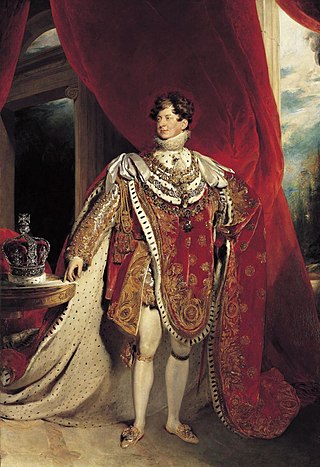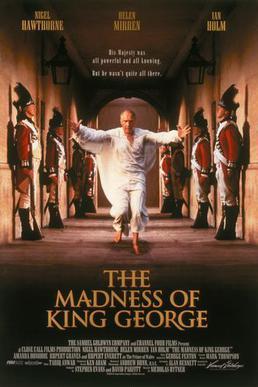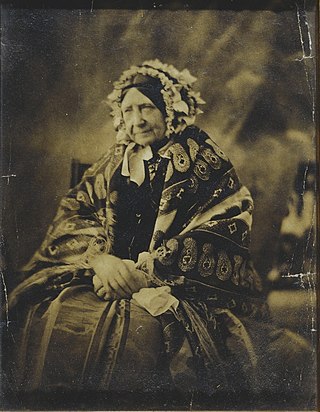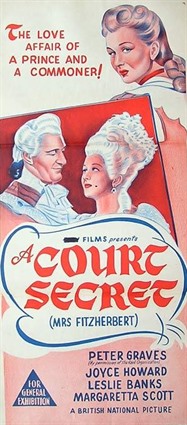
George IV was King of the United Kingdom of Great Britain and Ireland and King of Hanover from 29 January 1820 until his death in 1830. At the time of his accession to the throne, he was acting as prince regent for his father, King George III, having done so since 5 February 1811 during his father's final mental illness.

Caroline of Brunswick-Wolfenbüttel was Queen of the United Kingdom of Great Britain and Ireland and Queen of Hanover from 29 January 1820 until her death in 1821 as the estranged wife of King George IV. She was Princess of Wales from 1795 to 1820.

The Regency era of British history is commonly described as the years between c. 1795 and 1837, although the official regency for which it is named only spanned the years 1811 to 1820. King George III first suffered debilitating illness in the late 1780s, and relapsed into his final mental illness in 1810; by the Regency Act 1811, his eldest son George, Prince of Wales, was appointed prince regent to discharge royal functions. When George III died in 1820, the Prince Regent succeeded him as George IV. In terms of periodisation, the longer timespan is roughly the final third of the Georgian era (1714–1837), encompassing the last 25 years or so of George III's reign, including the official Regency, and the complete reigns of both George IV and his brother and successor William IV. It ends with the accession of Queen Victoria in June 1837 and is followed by the Victorian era (1837–1901).

The Madness of King George is a 1994 British biographical comedy drama film directed by Nicholas Hytner and adapted by Alan Bennett from his own 1991 play The Madness of George III. It tells the true story of George III of Great Britain's deteriorating mental health, and his equally declining relationship with his eldest son, the Prince of Wales, particularly focusing on the period around the Regency Crisis of 1788–89. Two text panels at the end of the film note that the colour of the King's urine suggests that he was suffering from porphyria, adding that the disease is "periodic, unpredictable and hereditary."

Maria Anne Fitzherbert was a longtime companion of George, Prince of Wales. In 1785, they secretly contracted a marriage that was invalid under English civil law because his father, King George III, had not consented to it. Fitzherbert was a Catholic and the law at the time forbade Catholics or spouses of Catholics from becoming monarch, so had the marriage been approved and valid, the Prince of Wales would have lost his place in the line of succession. Before marrying George, Fitzherbert had been twice widowed. Her nephew from her first marriage, Cardinal Weld, persuaded Pope Pius VII to declare the marriage sacramentally valid.

Princess Charlotte Augusta of Wales was the only child of George, Prince of Wales, and Caroline of Brunswick. She was expected to ascend the British throne after the deaths of her grandfather, George III, and her father, but died in childbirth at the age of 21, predeceasing them both.

Charlotte, Princess Royal, was Queen of Württemberg as the wife of King Frederick I. She was the eldest daughter and fourth child of George III of the United Kingdom and his wife, Charlotte of Mecklenburg-Strelitz.

Princess Mary, Duchess of Gloucester and Edinburgh was the eleventh child and fourth daughter of King George III and his consort Charlotte of Mecklenburg-Strelitz.

Carlton House, sometimes Carlton Palace, was a mansion in Westminster, best known as the town residence of King George IV, particularly during the regency era and his time as prince regent. It faced the south side of Pall Mall, and its gardens abutted St James's Park in the St James's district of London. The location of the house, now replaced by Carlton House Terrace, was a main reason for the creation of John Nash's ceremonial route from St James's to Regent's Park via Regent Street, Portland Place and Park Square: Lower Regent Street and Waterloo Place were originally laid out to form the approach to its front entrance.

Frances Villiers, Countess of Jersey was a British courtier and Lady of the Bedchamber, one of the more notorious of the many mistresses of King George IV when he was Prince of Wales, "a scintillating society woman, a heady mix of charm, beauty, and sarcasm".

Arthur Nigel Davenport was an English stage, television and film actor, best known as the Duke of Norfolk and Lord Birkenhead in the Academy Award-winning films A Man for All Seasons and Chariots of Fire, respectively.

A Royal Scandal is a 1996 British television docudrama produced and directed by Sheree Folkson. The teleplay by Stanley Price focuses on the ill-fated marriage of George IV and Duchess Caroline of Brunswick. Dialogue from actual historical records reveals how each party tries to humiliate the other, causing the monarchy to suffer great embarrassment. Narrated by Ian Richardson, the drama was broadcast by the BBC.
George III has featured in many examples of popular culture.
George IV of the United Kingdom has been depicted many times in popular culture.

The First Gentleman is a 1948 British historical drama film directed by Alberto Cavalcanti, and starring Jean-Pierre Aumont, Joan Hopkins, and Cecil Parker. It portrays the relationships and marriage of George, Prince Regent and his tense dealings with other members of his family such as his only child Princess Charlotte and his younger brother Frederick, Duke of York. It was also released as Affairs of a Rogue.The film is based on a play, The First Gentleman by Norman Ginsbury, which was staged in London in 1945, starring Robert Morley as the Prince Regent and Wendy Hiller as Princess Charlotte.

Victoria & Albert is a 2001 British-American historical television serial. It focused on the early life and marriage of Queen Victoria and Prince Albert. The series starred Victoria Hamilton as Victoria, Jonathan Firth as Prince Albert and Peter Ustinov as King William IV. It was directed by John Erman.

Mrs. Fitzherbert, also known as Princess Fitz and A Court Secret, is a 1947 black and white British historical drama film directed by Montgomery Tully and starring Peter Graves, Joyce Howard and Leslie Banks. It depicts the relationship between George IV and Maria Fitzherbert. It is an adaptation of the 1945 novel Princess Fitz by Winifred Carter
Since William the Conqueror claimed the English throne, succession has been determined by bequest, battle, primogeniture, and parliament.
Maria Molyneux, Countess of Sefton, was the wife of William Molyneux, 2nd Earl of Sefton.

The Carlton House Fête was hosted on 19 June 1811 by the Prince Regent, the future George IV, at his London residence Carlton House. Ostensibly held to honour the exiled Louis XVIII and French royal family, it functioned as a celebration of the establishment of George as Regent on behalf of his father George III. The lavish event set the tone amongst High Society during the Regency era.
















